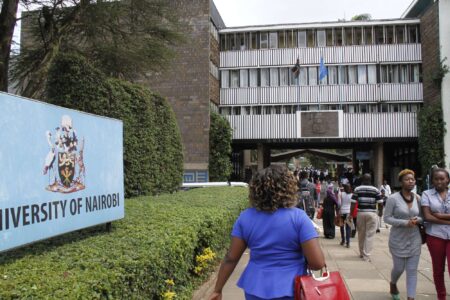Markets & Finance
Varsities got Sh241bn in six years in old funding model Hospitals report
Wednesday January 10 2024
University of Nairobi main entrance. PHOTO | FILE | NMG
Public universities were allocated Sh241.53 billion for student capitation for the six years that the State used the differentiated unit cost (DUC) model, which was phased out in July, 2023.
Official data shows allocations hit a high of Sh44 billion in the year ended June 2023, the last year of the DUC, compared to Sh33.3 billion allocated in the 2017/18 period— the first year of the formula.
Under DUC, institutions were allocated budgets based on the number of undergraduate students admitted and the types of courses they take.
The government phased out the DUC formula in July and introduced a new criterion where students will get funds based on their level of need, in an effort to ease pressure on the exchequer.
Read: Education gets Sh62bn more in mini- budget
An analysis of the data from the Universities Fund (UF) shows that University of Nairobi received the highest share of the money in the six years at Sh29.8 billion or 12 percent, highlighting the impact of the high number of students it admits.
DUC was plagued by delayed allocations from the National Treasury with the budget failing to match the sharp rise in State-sponsored learners enrolling at the varsities over the years.
UF – the State agency that advises the government on how to allocate funds to students in the varsities— says that the new funding formula is more responsive to the different income levels across households.
“Enrollment has been increasing while DUC has been declining hence the need for reforms in the university funding,” UF said while making the case for the new funding formula.
Kenyatta University took the second biggest share of the allocations at Sh18.84 billion or 7.8 percent, followed by Moi University at Sh18.6 billion (7.7 percent), Jomo Kenyatta University of Agriculture and Technology at Sh16.3 billion (6.7 percent).
Read: It’s now cheaper to study medicine at UoN than Moi and KU
But the universities are yet to get the allocated amounts even as the State dropped the DUC in favor of the needs-based model.
The big share of funding to the few public universities highlights their high enrollment numbers and cost courses that were key in determining allocation of the funds under DUC, which was introduced in 2016 where the government was to cater for 80 percent of the unit costs with the remaining 20 percent borne by households and institutions.
The DUC funding never hit the stipulated 80 percent and the highest was 66 percent in the 2018/19 financial year.
It remained on the decline and hit 48 percent in the year ended June 2023, hitting public universities that have since sunk into financial woes with at least Sh60 billion in unpaid bills and statutory deductions.
Increasing numbers of government-sponsored students in public universities against declining allocations from the National Treasury prompted the William Ruto administration to seek a new formula.
The new formula will be applied with the batch of government-sponsored students who joined universities in September last year.
Under the formula, the State is apportioning funds to students based on their levels of need classified into four— vulnerable, extremely needy, needy and less needy. The institutions of higher learning will be financed through scholarships at 80 percent and through loans at 20 percent.
→ (email protected)
→ (email protected)
